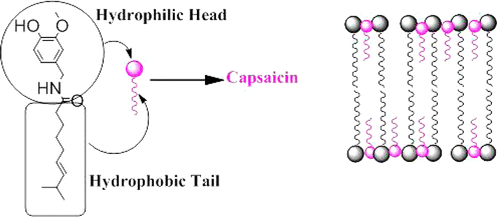How the 'heat' compound from chili peppers could help kill cancer cells

Capsaicin, the compound responsible for chilis' heat, is used in creams sold to relieve pain, and recent research shows that in high doses, it kills prostate cancer cells. Now researchers are finding clues that help explain how the substance works. Their conclusions suggest that one day it could come in a new, therapeutic form. Their study appears in ACS' The Journal of Physical Chemistry B.
About 10 years ago, researchers reported that capsaicin can kill prostate cancer cells in mice while leaving healthy cells unharmed. But translating that dose to humans would require them to eat a huge number of chili peppers per day. Figuring out how capsaicin works could help researchers transform it into an effective drug in the form of an injection or pill.
Researchers have figured out that the molecule binds to a cell's surface and affects the membrane, which surrounds and protects the cell. That finding prompted Ashok Kumar Mishra and Jitendriya Swain to try to gain a deeper understanding of capsaicin's effects so it might be harnessed in the future for new medicines.
The scientists were able to detect how the compound interacts with cell membranes by monitoring its natural fluorescence. The study showed that capsaicin lodges in the membranes near the surface. Add enough of it, and the capsaicin essentially causes the membranes to come apart. With additional research, this insight could help lead to novel tools against cancer or other conditions.
More information: Location, Partitioning Behavior, and Interaction of Capsaicin with Lipid Bilayer Membrane: Study Using its Intrinsic Fluorescence, J. Phys. Chem. B, Article ASAP. DOI: 10.1021/acs.jpcb.5b05351
Abstract
Capsaicin is an ingredient of a wide variety of red peppers, and it has various pharmacological and biological applications. The present study explores the interaction of capsaicin with dimyristoylphosphatidylcholine (DMPC) lipid bilayer membrane by monitoring various photophysical parameters using its intrinsic fluorescence. In order to have a clearer understanding of the photophysical responses of capsaicin, studies involving (i) its solvation behavior in different solvents, (ii) the partition coefficient of capsaicin in different thermotropic phase states of lipid bilayer membrane, and (iii) its location inside lipid bilayer membrane have been carried out. Capsaicin has a reasonably high partition coefficient for DMPC liposome membrane, in both solid gel (2.8 ± 0.1 × 105) and liquid crystalline (2.6 ± 0.1 × 105) phases. Fluorescence quenching study using cetylpyridinium chloride (CPC) as quencher suggests that the phenolic group of capsaicin molecule is generally present near the headgroup region and hydrophobic tail present inside hydrophobic core region of the lipid bilayer membrane. The intrinsic fluorescence intensity and lifetime of capsaicin sensitively respond to the temperature dependent phase changes of liposome membrane. Above 15 mol %, capsaicin in the aqueous liposome suspension medium lowers the thermotropic phase transition temperature by about 3 °C, and above 30 mol %, the integrity of the membrane is significantly lost.
Journal information: Journal of Physical Chemistry B
Provided by American Chemical Society
















